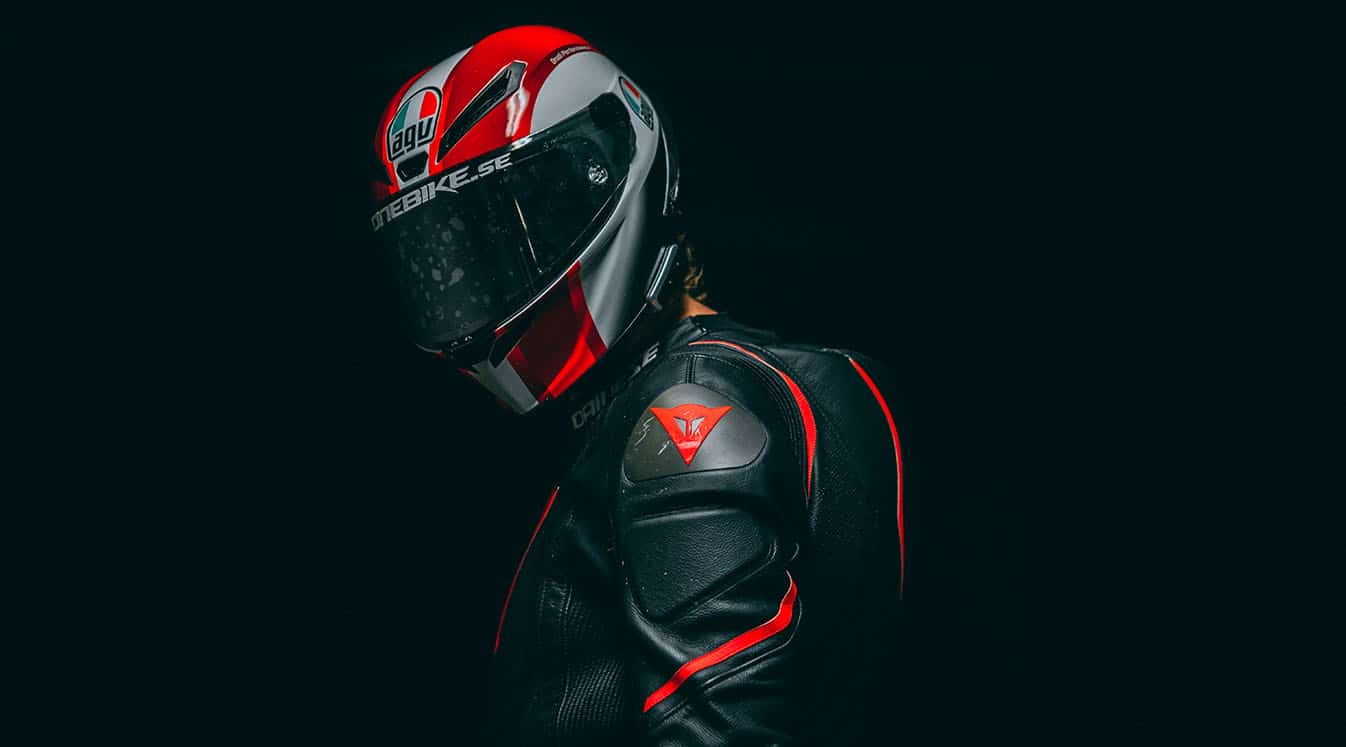In the modular vs. full face helmet debate, which comes out on top? Which will keep you safer on the road and in a crash? Which provides better everyday comfort? And which works better with the common motorcycle communication systems in use today? Here, we’ll look at the answers to these common questions.
Modular vs. Full Face: Understanding the History
When motorcycles first became popular in the early 20th century, full face helmets hadn’t even been invented. Open face helmets were the only game in town, and as you might imagine, they left a lot to be desired when it came to protecting a rider’s face in a crash. (Even today, open face helmets offer much less protection than either modular or full face helmets.)
Bell introduced the first full face helmets in the 1960s. They quickly became the standard choice for track and other competitive riders, and it wasn’t long before their popularity spread to the general population of motorcycle riders. The chin bar was among the most important innovations of the full face helmet, especially considering that nearly 35 percent of motorcycle crash impacts go to the chin—almost double the amount that any other zone receives.
However, many riders still wanted the convenience and breathability of a three-quarters helmet with a minimal compromise in protection. That’s why, in the later 20th century, modular helmets first emerged onto the scene. These helmets introduced a new feature: a chin bar and face shield that could be detached and rotated up with the press of a button.
Modular helmets gained popularity among touring riders and others who wanted solid protection with more breathability and versatility. Now, in the 21st century, full face helmets and modular helmets are both popular options for riders of all kinds. But many riders still wonder what the difference between modular and full face helmets is.
Modular Helmets: Pros and Cons
Modular helmets have become increasingly popular for their convenient and comfortable design. Here’s a quick rundown of their benefits and drawbacks.
Pros:
- A modular helmet can be a good compromise between the protection of a full face and the breathability of an open face helmet.
- Many riders love the ability to pop open the front of the helmet to grab some air, particularly if they ride in a hot climate.
- Modular helmets are good for riders who often need to communicate face-to-face with someone else while stopped. This is common for couriers and delivery people, as well as motorcycle riding instructors.
- Riders who wear eyeglasses sometimes find modular helmets easier to wear with their glasses.
- Modular helmets often include built-in tinted sun visors that aren’t as common in full face helmets.
- Riders who want to grab a quick drink of water or even a bite of granola bar at a stop will appreciate the convenience of a flip-up visor.
Cons:
- The chin bar of a modular helmet is not as well reinforced as that of a full face helmet. In a crash, you won’t receive quite the same level of face protection from a modular helmet as you would from a full face.
- Some evidence suggests that modular helmets do occasionally disengage their face shields during a crash, leaving the rider’s face exposed. (More on this in a minute.)
- Modular helmets are often slightly larger and heavier than comparable full face helmets because they need more internal mechanisms to flip the visor up.
- Riding with a modular helmet open is generally not recommended. If the wind grabs your visor, your helmet could be pulled off your head, and it could get snagged on something in a crash, which raises the possibility of a serious injury.
- Some riders experience more wind noise in modular helmets, although this can have as much to do with the individual helmet and fit as with the style.
Full Face Helmets: Pros and Cons
Full face helmets are the gold standard of motorcycle helmet protection. Let’s talk about why.
Pros:
- A full face helmet provides the best protection available for a motorcycle rider’s head, full stop. On a full face, the chin bar is integrated into the rest of the helmet’s structure in a way that makes it stronger than that of a modular helmet.
- If you plan on riding at a track day, you’ll almost always be required to wear a proper full face helmet.
- Because you never know when a crash will happen, always riding with a full face helmet will provide you with the best chance of walking away from a crash without serious injuries.
- Most modern full face helmets come with a visor piece that can be raised to clean it or get some air.
- Full face helmets tend to be lighter than modular helmets because they don’t have to accommodate the visor lifting mechanisms.
Cons:
- Some riders find full face helmets to be claustrophobic.
- Riders in hot climates may find that full face helmets are too stuffy and lack adequate ventilation.
- Visor fogging can be a problem for full face helmets in cold or humid weather, and it’s not nearly as easy to wipe off the visor on a full face as it is on a modular.
- If you wear eyeglasses, you may have trouble finding a full face helmet that fits comfortably around your glasses.
- Many full face helmets don’t include built-in sun visors.
Treat Your Ears to Our JBL Bluetooth Motorcycle Speakers
The shortest answer is that yes, a quality modular helmet is a generally safe and effective motorcycle helmet. It won’t provide you with quite the same level of protection you’d get from a true full face model, but it’s better than an open face helmet (so long as you’re riding with the chin bar closed) and it’s obviously far better than no helmet at all.
As mentioned previously, most of the safety concerns with a modular helmet revolve around the chin bar. In a modular helmet, the chin bar is not a unified piece with the rest of the helmet, which means it won’t be quite as strong as the chin bar in a full face helmet. But another relevant question is whether the locking mechanism on modular helmets can be trusted to stay in place during a crash.
Although the issue hasn’t been properly studied, anecdotal evidence suggests that modular helmets do occasionally disengage their chin bars in crashes. The problem is not widely reported, suggesting that it’s relatively uncommon, but it’s definitely something to be aware of when choosing a modular or full face helmet. To reduce the chance of this happening, choose a modular helmet from a well-regarded motorcycle helmet manufacturer with a good safety track record.
Why Aren’t There Any Snell-Certified Modular Helmets?
Let’s look a little closer at the safety of modular helmets. There are plenty of modular helmets available that meet the minimum DOT helmet standards. However, the DOT minimum is a low bar, and it’s usually better to look for something with the seal of approval from an organization with more rigorous helmet testing standards such as the Snell Foundation or the Economic Commission for Europe (ECE).
The Snell Foundation standard is widely considered to be the most rigorous available standard for motorcycle helmet safety, but unfortunately, they don’t currently certify any modular helmets.
Why? It’s because Snell holds any helmet with a chin bar to the same standards that it does a full face helmet. Well-made as any modular helmet may be, it will almost never meet the Snell chin bar standard because the standard is designed for a full face helmet.
What about ECE-approved modular helmets? There are a handful of them on the market today, and all are good quality helmets. The ECE also just revised its system for testing modular helmets to raise it to a higher standard, meaning that ECE-approved modular helmets will likely become even more reliable in the future.
Finding a Full Face Helmet That Breathes
A modular helmet isn’t the only way to get a helmet with better air circulation. Many of today’s full face helmets are designed with ventilation features that offer improved airflow throughout the helmet. These can be a great option for riders who want greater comfort without a compromise in safety.
Ventilation is one area in which you’ll often find that you get what you pay for. Less expensive full face helmets tend to skimp on airflow features to focus on the core protective qualities of the helmet. Many of the most breathable full face helmets are made by higher end helmet manufacturers like Shoei, Arai and Scorpion EXO.
These full face ventilation technologies come in many shapes and sizes. Vent scoops on areas like the chin and the crown of the head are standard, although their effectiveness can vary. Many of today’s helmets also feature perforated inner linings that allow airflow to move through them, while others include the option to lock the visor in a slightly cracked position to provide air circulation.
What about fogging? We’ve got one word for you: Pinlock. This visor company makes anti-fog inserts that are widely regarded as the industry standard. And if a Pinlock visor insert isn’t available or affordable for your helmet, there are other options like anti-fogging sprays and the charmingly named Cat Crap anti-fog lens wax.
Above all, finding a helmet with great ventilation is a matter of preference. The difference between individual riders’ head shapes can mean that a helmet that feels great for one person seems stuffy to another. Moreover, it’s often hard to tell how a helmet’s ventilation actually feels until you’ve put it through its paces on the road.
Helmet Intercom Systems
Lots of riders today use motorcycle communication systems while they’re on the road. A good motorcycle headset will allow you not only to talk with your buddies during a ride, but to use your GPS, playlists and phone hands-free.
Cardo Systems designs Bluetooth motorcycle speakers and microphones that are compatible with a wide range of helmets. But the microphones used in Cardo headsets do need to be installed a little differently depending on whether you have a full face or modular helmet.
On a full-face helmet, you’ll mount the microphone on a hook and loop patch (“velcro”) on the helmet’s chin. For a modular helmet, you’ll install the microphone as if you had an open face helmet, for which you’ll need to use a hybrid microphone. Either option will provide you with great sound quality and performance.
For more information on which helmet models are compatible with Cardo Systems units, see our Cardo Packtalk compatibility guide.
Keep in Touch with Cardo Motorcycle Bluetooth Headsets
We know the importance of a great helmet at Cardo Systems, and we offer lots of resources to help you find one. Take a look at our guide to the different types of motorcycle helmets to learn more about which helmet style is right for you, or learn about how a motorcycle helmet should fit. And for those who already have a helmet they like, use our guide to cleaning a motorcycle helmet to make sure your lid stays in great shape.





